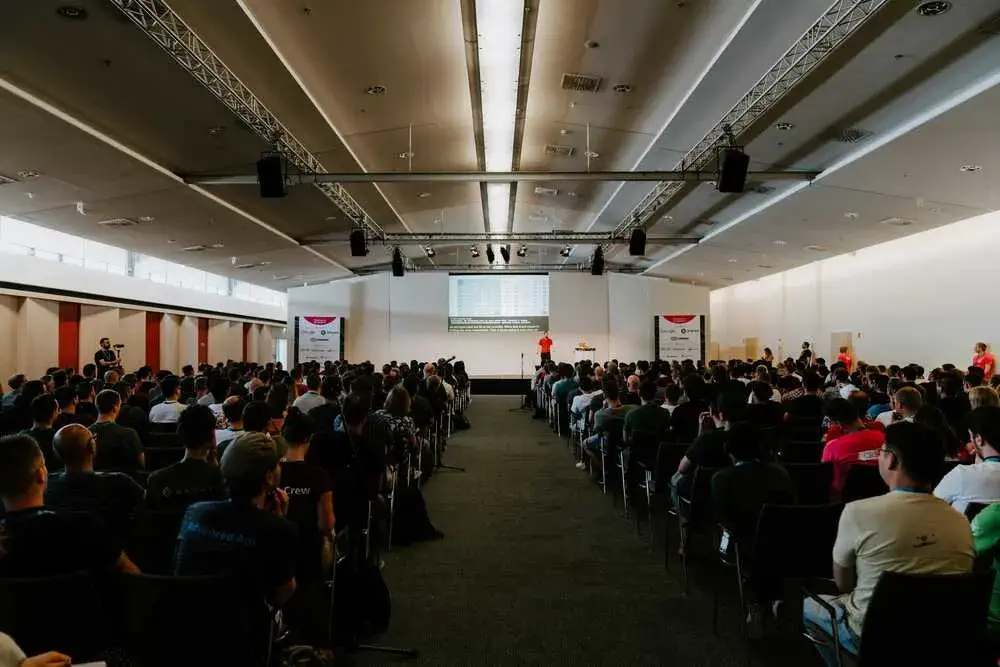Moderating a panel discussion is a great opportunity to explore insights from industry leaders and spark conversation about how their views relate to your company.
However, it’s deceivingly difficult for someone to do this well. Moderating a panel is an artful process that requires rapt attention for both your audience and your panelists so that the discussion both entertaining and informative.
Panels serve as a great way to spotlight an interesting discussion from various viewpoints and perspectives, but can quickly become chaotic or aimless.
The responsibility of moderating a panel is not unlike being a talk show host. You have to see yourself as the one who keeps up the interest and engagement levels of the audience by guiding discussion while letting your personality shine. Add your own thoughts in between, point out and play off of the audience’s reactions, and don’t shy away from having the panelists engage with one another.
At MeetingPulse, we have helped thousands of user moderate amazing panel discussions. So here’s our guide for moderators on how to run a great panel discussion of their own.
Related: How to Get People to Take a Survey
Tips to Moderate a Panel Discussion
The magic happens when a panel transforms into a provocative brainstorm between intellectual thought-leaders. Here’s a summary of some tips and tricks for moderating a panel discussion. We’ll go into more depth below.
- Do your research — A panel discussion moderator’s role is more than just prepping your panelists’ bios. Keep reading to find out what you should research.
- Prepare a schedule — It’s important to have an entire schedule ready from start to finish, but one that gives you flexibility.
- Pay attention to setup — Environment plays a significant role when it comes to speeches and discussions, and can make all the difference in engagement.
- Be neutral — One key responsibility as a moderator is to keep your biases in check — that means no loaded questions!
- Involve the audience — Get the audience involved when you can, using Q&A sessions, polls, and raffles.
- Start strong — Create a dynamic opening and let your audience know why they’re there.
- End strong — Find out how to end with the right questions and answers.
1. Do Your Research

Know your topic
Much like any other event, a panel discussion, too, requires research on the moderator’s part.
This doesn’t just mean prepping your panelists’ bios, but delving into topics so you can ask nuanced questions. Look up the topic and read multiple sources to gain a balanced understanding. This way, you’ll be well-informed enough to chime in and ask questions that will propel the discussion further.
Know your panelist
Knowing your panelists and their viewpoints on the particular topic is of the utmost importance. Try to request for a meeting or at least a phone call before the panel discussion. If you’re lucky, you might know some of the panelists beforehand.
Make sure you ask them if there are any particular fine points they want to touch upon or topics from which they want to veer away.
Know everything about their current work, previous achievements, the causes they support, and so on. Doing this will allow you to get to know them personally, too, so you can lighten the discussion with funny anecdotes.

2. Prepare a Schedule
Being prepared as a panelist doesn’t just mean knowing what questions you’re going to ask, but having an entire schedule ready from start to finish.
This begins with introducing the panelists and ends with a Q&A session with the audience. Have a list of all the questions you will be asking the panelists, and hand out these questions to the panelists before the discussion begins.
You can take either a structured or an unstructured approach, keeping a gap between different segments of the discussion or using a loose framework while taking audience questions periodically.
Using the MeetingPulse Q&A feature to gather audience questions with minimal distraction, letting audience members submit questions as they think of them and letting you ask their submitted questions aloud when you see an organic opportunity.
This tool will enable you to manage your time effectively; whereas Q&A sessions often yield irrelevant, distracting, or similar questions, MeetingPulse live meeting Q&A sessions help you sort through them to ask the ones that really matter.
3. Pay Attention to Setup
It’s a known fact that the ambiance plays a huge role as far as speeches and discussions are concerned, the stage setup of a play.
A positive atmosphere automatically charges up the audience and the mood of the speakers as well. Before the discussion begins and the audience starts pouring in, a moderator should walk around the room to check if everything is set up well.
Be it the type of furniture and its placement, or the seating arrangement, screen, and the microphones, everything needs to be checked and moderated in advance.
As far as the seats are concerned, do away with tables, and keep armchairs instead. They are much more comfortable to sit on, and the more comfortable your panelists are, the smoother the discussion will be.
Also, make sure to keep stools away. More often than not, high stools make it uncomfortable for people to sit on and talk while trying to maintain their posture as well.
Related: 33 Fun Poll Questions to Ask Your Audience

4. Be Neutral
Your most important responsibility as a moderator is to keep your biases in check and be absolutely neutral. Let the panelists shape the discussion and the argument. Don’t say words and phrases like, “You’re absolutely correct‚” “I don’t think that’s right‚” and so on.
An occasional interjection like, “That’s interesting,” or “Tell me more about that,” is more appropriate. Let the audience listen to what the panelists have to say, and form their own opinion.
Being neutral also begins with inviting a diverse panel. Give everyone a chance to speak, and see to it that no one’s views or statements are neglected. Thank each speaker for their opinion, and move on to the next person. Don’t show bias towards one panelist over another.

5. Involve the Audience
Some moderators prefer to keep the questions from the audience for the final segment.
However, it’s always more interesting to get the audience involved whenever possible. If you see that a particular answer is getting a roaring reaction from the audience, follow it up by asking related questions to the panelists.
Don’t be afraid to switch things up a little. It gets mundane if the panelists keep talking throughout the session. Getting the audience involved with their thoughts and comments helps in spicing up the session.
One way to do this is by allowing them to submit questions live. While it’s a good idea to invest in microphones for the audience, you can use technology like MeetingPulse to gather audience response questions that gives a deeper level interaction like voting and commenting.
6. Start Strong
The way you begin a panel discussion is crucial as it sets the tone for the rest of the discussion,. Create a dynamic opening. Get your audience excited. They should know exactly why they’re there and why each specific panelist was chosen.
Your audience will be able to connect better to the discussion if you highlight the key themes and topics that you’ve gathered from your in-depth research.
You can also run a warm-up poll by asking the audience a certain question related to the panel discussion, and then go through the poll’s results with the panelists. This helps to establish a warm and easy atmosphere, and also helps in building a rapport between the speakers and the audience.
At this point, you know the panelists more than your audience knows the panelists. If you do not provide enough context for the event, the meeting might feel like an executive decision that was made with little to no input from other employees.
Showing the employees why you chose these panelists reminds them that you want to be inclusive, fun, and foster collaborative learning.
7. End Strong
“Any questions left from the audience?…No?….I guess that’s it.”
Most people have been to at least one meeting like this, where questions die down and the moderator lets the audience trickle off. The end of a meeting should be smooth and not abrupt, and it’s the moderator’s task to tie up loose ends.
In order to do this, the moderator should begin by introducing the last question as such. They can avoid awkward endings with MeetingPulse, allowing audience members to submit Q&A questions instead of asking them blindly. Then, a moderator can choose the relevant Q&A questions and decide which one will be the last.
After the questioning session ends, the moderator can synthesize information as a way to summarize the event and encourage retention. They can pull quotes or subject matter from the panelists’ talks to show them that they were listening closely, and remind listeners why these components matter to the company.
Finally, the moderator should thank the panelists for their time and let the audience know how to connect with them best.
Summing Up
As a moderator, you’re the driving force behind a panel discussion. Therefore, it’s on you to see that the discussion is both fun as well as informative.
Don’t just ask typical questions; do your research properly and make sure you include the background and knowledge of each panelist into the discussion. Keep the audience engaged, too.
Probe for a deeper insight into every topic, and once you hear that roaring round of applause, you’ll know you’ve done your job as a moderator.
Get started with engaging events by checking out our capabilities at MeetingPulse.
Related: The Importance of Consistency Between Corporate Culture and Branding








